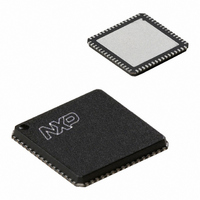LPC2138FHN64/01,55 NXP Semiconductors, LPC2138FHN64/01,55 Datasheet - Page 21

LPC2138FHN64/01,55
Manufacturer Part Number
LPC2138FHN64/01,55
Description
IC ARM7 MCU FLASH 512K 64-HVQFN
Manufacturer
NXP Semiconductors
Series
LPC2100r
Specifications of LPC2138FHN64/01,55
Program Memory Type
FLASH
Program Memory Size
512KB (512K x 8)
Package / Case
64-VQFN Exposed Pad, 64-HVQFN, 64-SQFN, 64-DHVQFN
Core Processor
ARM7
Core Size
16/32-Bit
Speed
60MHz
Connectivity
I²C, Microwire, SPI, SSI, SSP, UART/USART
Peripherals
Brown-out Detect/Reset, POR, PWM, WDT
Number Of I /o
47
Ram Size
32K x 8
Voltage - Supply (vcc/vdd)
3 V ~ 3.6 V
Data Converters
A/D 16x10b; D/A 1x10b
Oscillator Type
Internal
Operating Temperature
-40°C ~ 85°C
Processor Series
LPC21
Core
ARM7TDMI-S
Data Bus Width
16 bit, 32 bit
Data Ram Size
32 KB
Interface Type
I2C/SPI/SSP/UART
Maximum Clock Frequency
60 MHz
Number Of Programmable I/os
47
Number Of Timers
2
Operating Supply Voltage
3 V to 3.6 V
Maximum Operating Temperature
+ 85 C
Mounting Style
SMD/SMT
3rd Party Development Tools
MDK-ARM, RL-ARM, ULINK2, KSK-LPC2138, KSK-LPC2138-PL
Development Tools By Supplier
OM10045, OM10070, OM10089
Minimum Operating Temperature
- 40 C
On-chip Adc
2 (8-ch x 10-bit)
On-chip Dac
1-ch x 10-bit
Lead Free Status / RoHS Status
Lead free / RoHS Compliant
For Use With
568-4310 - EVAL BOARD LPC2158 W/LCD568-4298 - BOARD EVAL LPC213X KS213X568-4297 - BOARD EVAL LPC21XX MCB2100MCB2130UME - BOARD EVAL MCB2130 + ULINK-MEMCB2130U - BOARD EVAL MCB2130 + ULINK2MCB2130 - BOARD EVAL NXP LPC213X ARM FAM622-1005 - USB IN-CIRCUIT PROG ARM7 LPC2K568-2095 - BOARD EVAL FOR LPC213X ARM MCU
Eeprom Size
-
Lead Free Status / Rohs Status
Lead free / RoHS Compliant
Other names
568-4011
935281779557
LPC2138FHN64/01
935281779557
LPC2138FHN64/01
NXP Semiconductors
LPC2131_32_34_36_38
Product data sheet
6.17.1 Features
6.17 Pulse width modulator
The PWM is based on the standard Timer block and inherits all of its features, although
only the PWM function is pinned out on the LPC2131/32/34/36/38. The Timer is designed
to count cycles of the peripheral clock (PCLK) and optionally generate interrupts or
perform other actions when specified timer values occur, based on seven match registers.
The PWM function is also based on match register events.
The ability to separately control rising and falling edge locations allows the PWM to be
used for more applications. For instance, multi-phase motor control typically requires
three non-overlapping PWM outputs with individual control of all three pulse widths and
positions.
Two match registers can be used to provide a single edge controlled PWM output. One
match register (MR0) controls the PWM cycle rate, by resetting the count upon match.
The other match register controls the PWM edge position. Additional single edge
controlled PWM outputs require only one match register each, since the repetition rate is
the same for all PWM outputs. Multiple single edge controlled PWM outputs will all have a
rising edge at the beginning of each PWM cycle, when an MR0 match occurs.
Three match registers can be used to provide a PWM output with both edges controlled.
Again, the MR0 match register controls the PWM cycle rate. The other match registers
control the two PWM edge positions. Additional double edge controlled PWM outputs
require only two match registers each, since the repetition rate is the same for all PWM
outputs.
With double edge controlled PWM outputs, specific match registers control the rising and
falling edge of the output. This allows both positive going PWM pulses (when the rising
edge occurs prior to the falling edge), and negative going PWM pulses (when the falling
edge occurs prior to the rising edge).
•
•
•
•
•
Seven match registers allow up to six single edge controlled or three double edge
controlled PWM outputs, or a mix of both types.
The match registers also allow:
– Continuous operation with optional interrupt generation on match.
– Stop timer on match with optional interrupt generation.
– Reset timer on match with optional interrupt generation.
Supports single edge controlled and/or double edge controlled PWM outputs. Single
edge controlled PWM outputs all go HIGH at the beginning of each cycle unless the
output is a constant LOW. Double edge controlled PWM outputs can have either edge
occur at any position within a cycle. This allows for both positive going and negative
going pulses.
Pulse period and width can be any number of timer counts. This allows complete
flexibility in the trade-off between resolution and repetition rate. All PWM outputs will
occur at the same repetition rate.
Double edge controlled PWM outputs can be programmed to be either positive going
or negative going pulses.
All information provided in this document is subject to legal disclaimers.
Rev. 5 — 2 February 2011
LPC2131/32/34/36/38
Single-chip 16/32-bit microcontrollers
© NXP B.V. 2011. All rights reserved.
21 of 45















